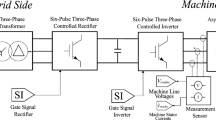Abstract
Frequency-controlled electric drives constructed according to the scheme “frequency converter–ac electric motor” are widely used in modern technology and electric drive systems of various vehicles. At the moment, many methods of modulating the voltage at the output of the frequency converter have been developed in order to bring its shape closer to the sinusoidal one with the lowest losses. Since, depending on the task at hand, different characteristics of voltage modulation are prioritized, it is necessary to know the advantages and disadvantages of the main algorithms for generating voltage at the output of the frequency converter. A feature of high-power electric drive systems is the impossibility of using high switching frequencies of the power switches of the frequency converter, which makes it necessary to know the laws of the formation of the voltage spectrum when using a particular method. The article considers the basic algorithms for generating voltage at the output of a frequency converter without feedback: scalar and spatial-vector pulse-width modulation and computational algorithms for voltage formation, as well as a comparative analysis of the spectra and the nonsinusoidality coefficient at comparable switching frequencies of power switches, performed both analytically, which gives an idea of the principles of forming the voltage spectrum, and by modeling processes in MATLAB/Simulink.





Similar content being viewed by others
REFERENCES
Grahame, D.G. and Lipo T.A., Pulse Width Modulation for Power Converters: Principles and Practice, Hoboken, NJ: Wiley, 2003.
Gupta, A.K. and Khambadkone, A.M., A general space vector PWM algorithm for multilevel inverters, including operation in overmodulation range, with a detailed modulation analysis for a 3-level NPC inverter, Proc. 2005 IEEE 36th Power Electronics Specialists Conf., Red Hook, NY: Curran Assoc., 2005.
Belousov, I.V., Samoseiko, V.F., and Brovtsinova, L.M., Comparative analysis of the pulse width modulation methods, Vestn. Gos. Univ. Morsk. Rechn. Flota im. S.O. Makarova, 2018, no. 10 (2).
Wells, J.R., et al., Generalization of selective harmonic elimination/control, Proc. 2005 IEEE 36th Power Electronics Specialists Conf., Red Hook, NY: Curran Assoc., 2005.
Saleh, S.A. and Azizur Rahman, M., An Introduction to Wavelet Modulated Inverters, Hoboken, NJ: Wiley, 2011.
Author information
Authors and Affiliations
Corresponding author
Additional information
Translated by F. Baron
About this article
Cite this article
Dobroskok, N.A., Lavrinovskiy, V.S. Spectral Analysis of Basic Algorithms of Pulse-Width Modulation Control without Feedback in Two-Level Frequency Converters. Russ. Electr. Engin. 92, 139–144 (2021). https://doi.org/10.3103/S1068371221030044
Received:
Revised:
Accepted:
Published:
Issue Date:
DOI: https://doi.org/10.3103/S1068371221030044



